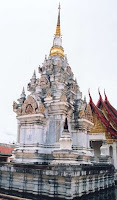As I am most interested in Surat Thani province, it was this province I tried hardest to find sources on its history. But due to its more complicated history, the English sources I found are somewhat contradicting. It's especially the
thesaphiban reforms and its effects on Surat Thani which I am talking about now. At first I will present the history as I right now think is most correct, hopefully I am not too far from reality.
1896 the
Monthon Chumphon was created, consisting of the four provinces (
Mueang) Chumphon, Lang Suan, Chaiya and Kanchanadit. The center of Kanchanadit was in fact located in Ban Don, the modern-day district Kanchanadit only covers the older location at Tha Thong Mai - the name Kanchanadit was bestowed on Tha Thong during the reign of King Rama V. In October 1899 the Mueang Kanchanadit and Chaiya were merged (
Gazette), and the center set to Ban Don but the name Chaiya was retained. 1906 the monthon administration was moved to Ban Don as well. In August 1915 the province was renamed to Surat Thani, while the Monthon was renamed from Chumphon to just Surat (
Gazette).
The first two sources I found while researching for the Wikipedia article on the province was the Golden Jubilee Network (Kanchanaphik), which had informative pages on the provinces. Strangely these pages went blank some years before, and apparently no webmaster ever checked and fixed this. So the text I am talking about is
only available from archive.org.
Later, it was divided into Chaiya, Tha Thong and Kiri Raj towns which were governed by Nakhon Si Thammarat town. In the reign of King Rama IV, Tha Thong town was moved to Ban Don (present town) and governed by Bangkok. The name Tha Thong was changed to Kanchanadit Town. Due to the change in the country administrative system, King Rama V combined Chaiya, Kanchanadit, Lang Suan and Chumporn together to be called Chumporn . In 1898, the municipal hall was built in Chumporn but it was moved to Ban Don in 1915, in the reign of King Rama VI. This place was re-named “Surat Thani”.
The second one, also not online anymore, was from a site named
Goods-thThe Thong and Khiri Rat were annexed to Nakhon Si Thammarat, while Chaiya reported directly to Ayutthaya. After Ayutthaya fell to Burma in 1767, Chaiya fell under Nakhon Si Thammarat. King Rama IV moved the administration and Tha Thong to Ban Don, and renamed it "Kanchanadit". Which was to report directly to Bangkok.
King Rama V In 1896: The regional administration center was established. The so-called Monthon Chumphon looked after Kanchanadit (or Ban Don). Chaiya, and Khiri Ratthanikhom.
So both sources list Khirirat Nikhom as a third province which existed in the area of Surat Thani. However, as the Gazette announcement cited above only lists Kanchanadit and Chiaya, this must have been demoted before. This confusion probably arises due to the fact that
Mueang not just named the provinces directly under the central government, but also the minor
Mueang which were subordinate of another
Mueang.
Even Tej Bunnags "Provincial Administration of Siam" added more confusion, as in Appendix III it lists the provinces within each monthon, and for Chumphon/Surat it says
Chumphon, and then Suratthani, Chaiya,
Kanchanadit, Langsuan
which sounds like there were three - Surat Thani, Chaiya and Kanchanadit.
Another version in Wolf Donner's
Five faces of Thailand lists instead another additional
Mueang, this time Khiri Wong. On page 464f. it says:
South of Chumphon we find the rather large changwat of Surat Thani with a capital that received its present name from Rama VI meaning "the town of the good people". Originally, this province was part of Nakhon Si Thammarat but it was, towards the end of the last century, separated under the name of Kanchanadit or Ban Don, with the capital of the latter name. Today the changwat encloses the old provinces of Chaiya and Kiriwong and reaches close to the west coast.
My interpretation is however backed by the Thai book "
Our Surat Thani", which only talks on the histories of Chaiya and Kanchanadit.
If you're still with me here after all these texts you can imagine how much difficult it often is to write well-researched articles on the Thai provinces or districts in Wikipedia.














